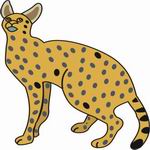- Servals have relatively the largest ears and the longest legs in
the cat family.
- Their feet are actually elongated rather than their legs.
- With long necks, their heads are small and slim.
- Their pelage is tawny-gold in color and marked with round black spots.
- Servals are found in many parts of Africa, but not in the equatorial
jungles or the Sahara.
- It is most commonly found in East African savannas, usually near
water.
- They prefer areas of scrub bush, tall grass and dry reed beds that
are near streams.
- Servals are rodent specialists, 89% of their kills have been estimated
as mammalian. Caracals, although quite similar in ecology, tend to take
rather larger prey.
- More than 90% of the Serval's prey weighs less than 200 grams, less
than two percent of the average body weight of a female.
- Servals prey on hares, ground squirrels, hyraxes, snakes, lizards,
mole rats, frogs, insects, birds (quails, flamingoes, quelea, and teal
- Though Serval can climb, they hunt exclusively on the ground. They
walk slowly through tall grass and listen for movement.
- A Serval weighs between 29 and 41 pounds, its body length is 27 -39
inches with an added tail length of about 13 - 17 inches.
- The height at the shoulder is about 23 inches.
- Males are slightly larger than females.
- Elusive and shy, Servals are for the most part nocturnal, hunting
by sight and sound more than scent.
- It has an excellent sense of hearing and can locate prey that is moving
underground. Once it hears its prey, the Serval will quietly approach
and then leaping, will pounce on it. Often, they will play with their
meal before consuming it.
- Gestation - Approximately 68 - 72 days.
- LIFE SPAN: Averages roughly 13 years
- Litter size is 1 - 5, usually 2 - 3.
- SEXUAL MATURITY:- 1-2 years
|


